The American Federation of State, County and Municipal Employees Council 31 is the largest government worker union in Illinois. It claims to be a “leading voice for working families in the state of Illinois.”1
But do its members agree with what that “voice” is saying?
Every year, Council 31, its political action committee, and its national counterpart, AFSCME headquarters,2 funnel millions of dollars to political candidates and causes.
Unfortunately, it’s difficult – if not impossible – for members to know exactly where that money goes. And unless members spend days combing through hundreds of pages of federal and state reporting documents, they will never know.
AFSCME counts on that. The complexity of spending reporting allows union leadership to clandestinely direct funds to politicians and to causes its members may oppose.
This report evaluates AFSCME’s political spending – and, therefore, the union’s utilization of members’ dues3 – by examining state and federal reporting documents that provide a glimpse into the priorities of Council 31’s PAC, Council 31 itself and AFSCME headquarters. The results are as follows:
First, filings with the Illinois State Board of Elections reveal Council 31’s PAC spent more than $6.8 million on political causes and candidates for office in Illinois in 2013 through 2017. Of that amount, almost $2.8 million was directed toward the election committees of current state lawmakers.
The PAC’s political spending reveals a number of findings. For example, at least 74 percent of its overall political spending in Illinois over the five-year period between 2013 and 2017 was directed to Democrats, such as House Speaker Mike Madigan. In fact, in his role as chairman of multiple political funds, Madigan was the top recipient of AFSCME political spending from 2013 to 2017 – receiving more than $541,000. That spending spikes in election years, when the union is particularly committed to getting Democrats elected. And a whopping 104 of the current 177 state lawmakers – or nearly 3 in 5 – received money from Council 31’s PAC.
Second, federal reporting documents reveal that Council 31 spent more than $7.7 million on political activities and lobbying from 2013 to 2017 – but lax reporting requirements allow the union to hide the full array of its political spending.
AFSCME doesn’t have to specifically list all political activities or lobbying it financially supports. In fact, the bulk of AFSCME’s political spending is on political activities and lobbying performed by its officers and employees – but the union does not have to list in what political activities or lobbying those officers or employees participated. Furthermore, AFSCME has a lot of leeway in what it must categorize as “political” spending, and can thereby downplay how much money it actually directs to political activities.
Finally, federal reporting documents reveal AFSCME headquarters spent more than $205 million on political activities and lobbying from 2013 to 2017. That spending was spread across the United States to politicians, organizations and political committees.
Because all members of Council 31 are also members of AFSCME headquarters, a portion of their dues is directed to the union at the national level – and, therefore, to the political activities the headquarters supports.
These state and federal reporting documents reveal the majority of AFSCME political spending favors Democrats and left-leaning, progressive committees and organizations. Considering that polling reveals roughly 40 percent of union households have voted Republican in every presidential election since 2000,4 AFSCME’s priorities appear at odds with the political leanings of a significant percentage of its members, who have no voice in how union leadership spends their hard-earned money.
That changes following the U.S. Supreme Court’s June 2018 decision in Janus v. AFSCME. Following that decision, government workers represented by AFSCME can decide for themselves whether to fund the union and its political activities. They simply need to opt out of their unions and tell their employers to stop deducting union fees from their paychecks.
FOLLOWING THE MONEY: AFSCME COUNCIL 31’S PAC SPENDS MILLIONS ON ILLINOIS POLITICS
Council 31 doesn’t make it easy to track its money trail. It shuffles money derived from membership dues from one affiliated account or organization to another.
One common recipient of Council 31’s funds in the past five years: the union’s political account.5 The political account, in turn, funneled money to its political action committee, AFSCME Illinois Council 31 PAC.6
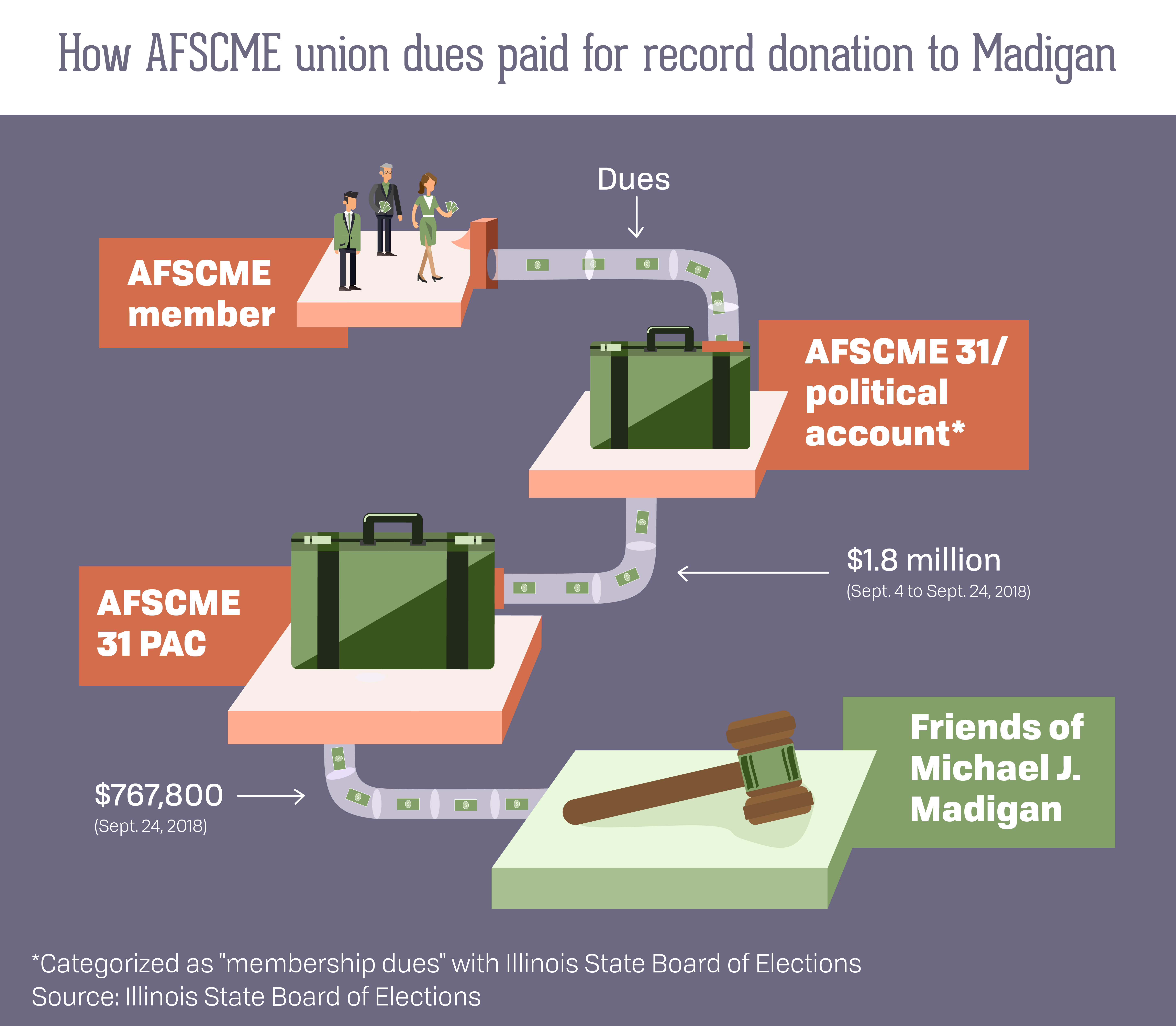
Where did the money go from there? According to records with the Illinois State Board of Elections, Council 31’s PAC spent over $6.8 million between 2013 and 2017 on Illinois politics.7
A breakdown of the PAC’s political spending from 2013 to 2017 reveals the following:
- 74 percent of the PAC’s political spending was directed toward Democrats, with Republicans receiving only 6 percent.
- House Speaker Mike Madigan – through the campaign committees he controls – was the top recipient of AFSCME Council 31 political spending, receiving more than $541,000.
- The PAC’s political spending spikes in election years.
- The PAC spent almost $2.8 million in the past five years on current state lawmakers, with more than $2.6 million (96 percent) going to Democrats.
- 104 of 177 current lawmakers have received money from AFSCME’s PAC – including 88 percent of current Democratic lawmakers.
Not all AFSCME members agree with those spending priorities. Nonetheless, their dues money is directed wherever Council 31’s leadership wants it to go.
Finding No. 1: 74 percent of AFSCME’s PAC spending was directed to Democrats – with only 6 percent directed to Republicans
AFSCME’s PAC directed at least $6,806,091 to election committees and other political action committees in Illinois from 2013 to 2017.8 Of that amount, at least $5 million (74 percent) was directed to Democratic candidates or committees.9 A little more than $400,000 (6 percent) went to Republicans.10 The remainder went to committees or organizations not necessarily tied to a political party.11
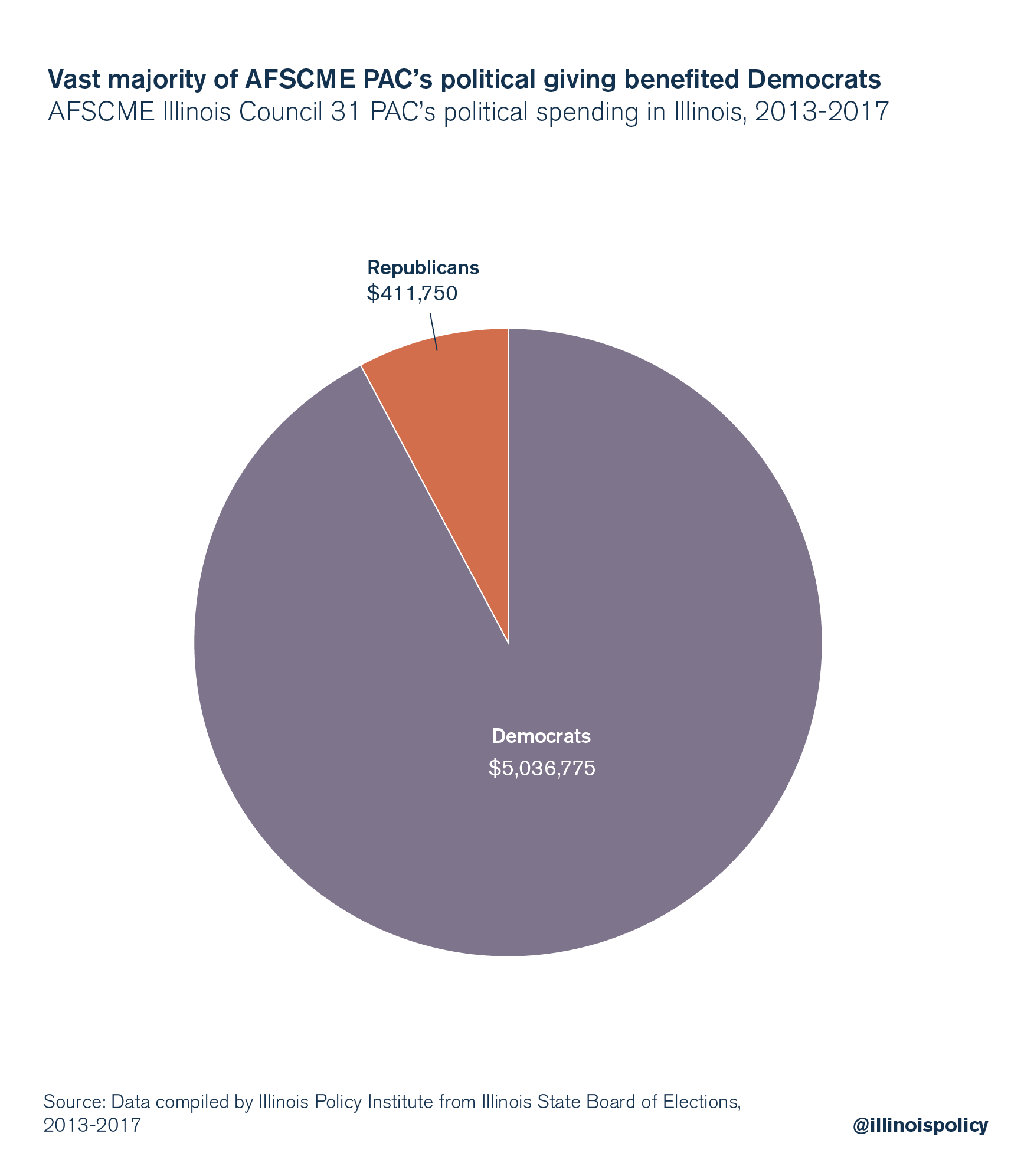
Finding No. 2: Madigan was the top recipient of AFSCME Council 31 political spending
A look at the top 10 recipients of the PAC’s political spending reveals the union’s political preferences: It spends big on big-name Democrats.
The top recipient of AFSCME’s political funding between 2013 and 2017 was Illinois House Speaker Mike Madigan. Between his campaign committee (Friends of Michael Madigan), the Democratic Party of Illinois (which Madigan chairs) and Democratic Majority (which Madigan also chairs), the speaker took in more than $541,000 from Council 31 during that time. Of course, this total would not include funds Council 31 sent directly to other Democratic lawmakers backed by the speaker, at his direction.
Among individual campaign funds, the top recipient of Council 31 money was the committee of former state Rep. Mike Smiddy, a Democrat, which received more than $212,000.12 Following Smiddy is Madigan, whose campaign committee received more than $163,000 from AFSCME’s PAC during that time.13 Also making the top 10: Senate President John Cullerton.14
Only one Republican – former gubernatorial candidate and state Sen. Kirk Dillard – made the top 10.15
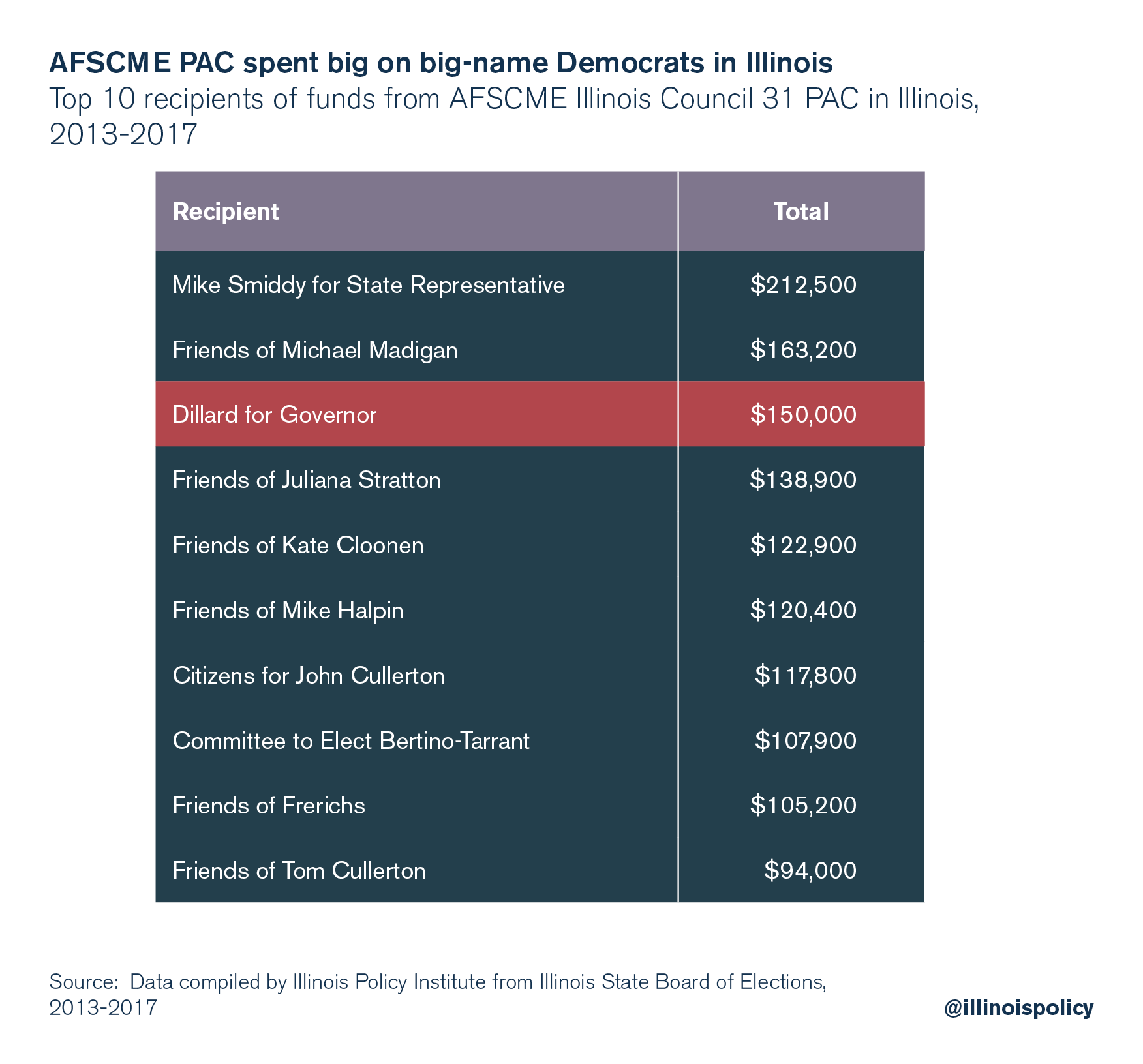
The PAC directed more than $215,000 to the Democratic Party of Illinois and more than $163,000 to Democratic Majority – Madigan is the chairman of both.16 In contrast, the PAC gave just $7,500 to the Downstate GOP Caucus.17
Finding No. 3: AFSCME’s political spending spiked in election years
The PAC’s key purpose is evident in its giving to Democrats and Republicans by year. It was more active in even-numbered years – i.e., election years – than it was in odd-numbered years. Democrats especially benefited from AFSCME’s election-year political activity.18
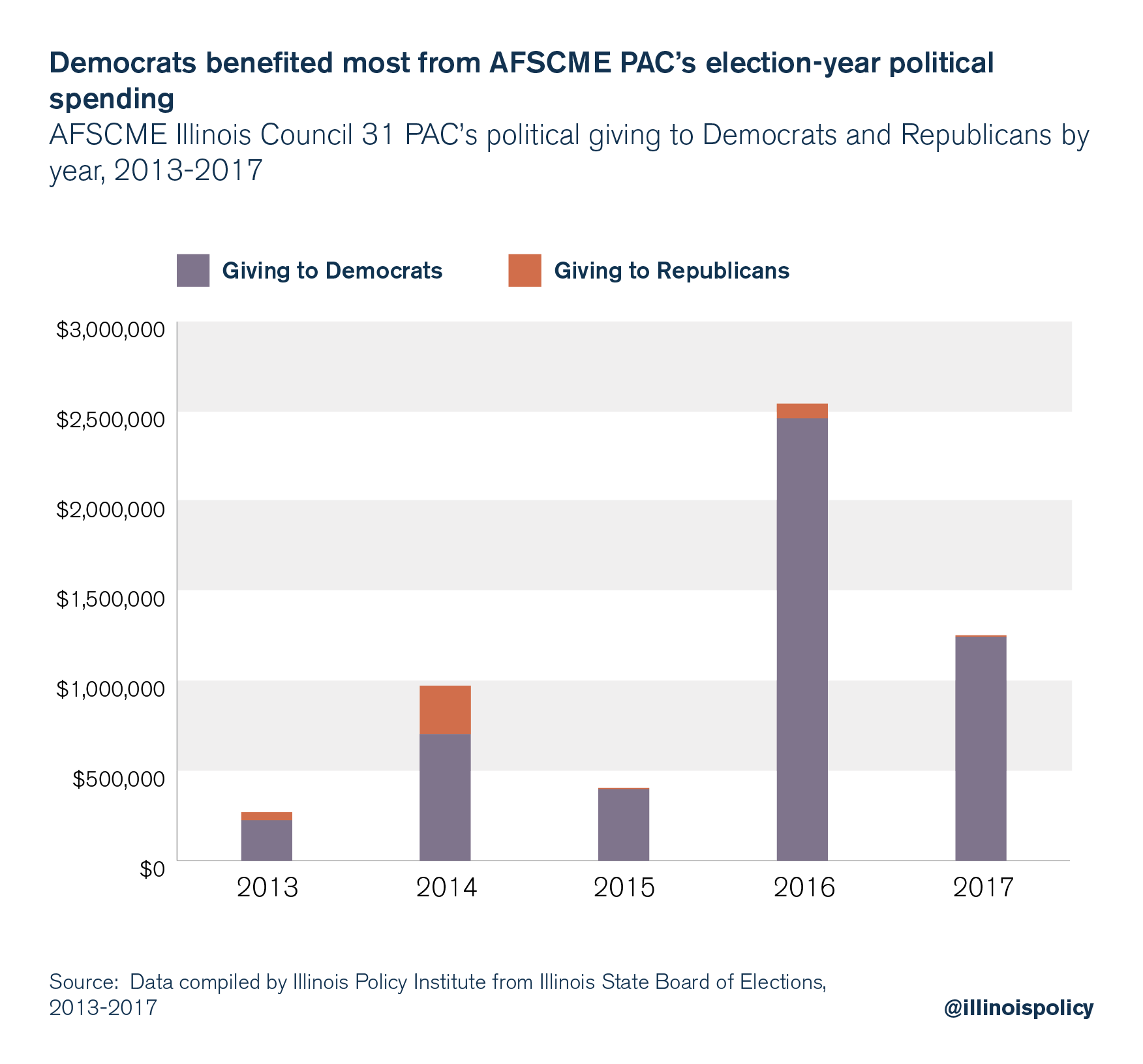
Finding No. 4: AFSCME’s PAC spent almost $2.8 million on current state lawmakers, with more than $2.6 million (96 percent) going to Democrats
AFSCME’s PAC spent millions on the election committees of current state lawmakers who, once elected, made important decisions on labor policy, pensions and other matters affecting both the union and taxpayers.
Filings reveal that between 2013 and 2017, the PAC directed more than $2.78 million to the election committees of lawmakers currently sitting in the General Assembly.19 And as with its overall giving, the majority of that spending – almost $2.7 million (96 percent) – was directed toward the election committees of Democrats.20 Filings show Republican election committees received only $101,000.21
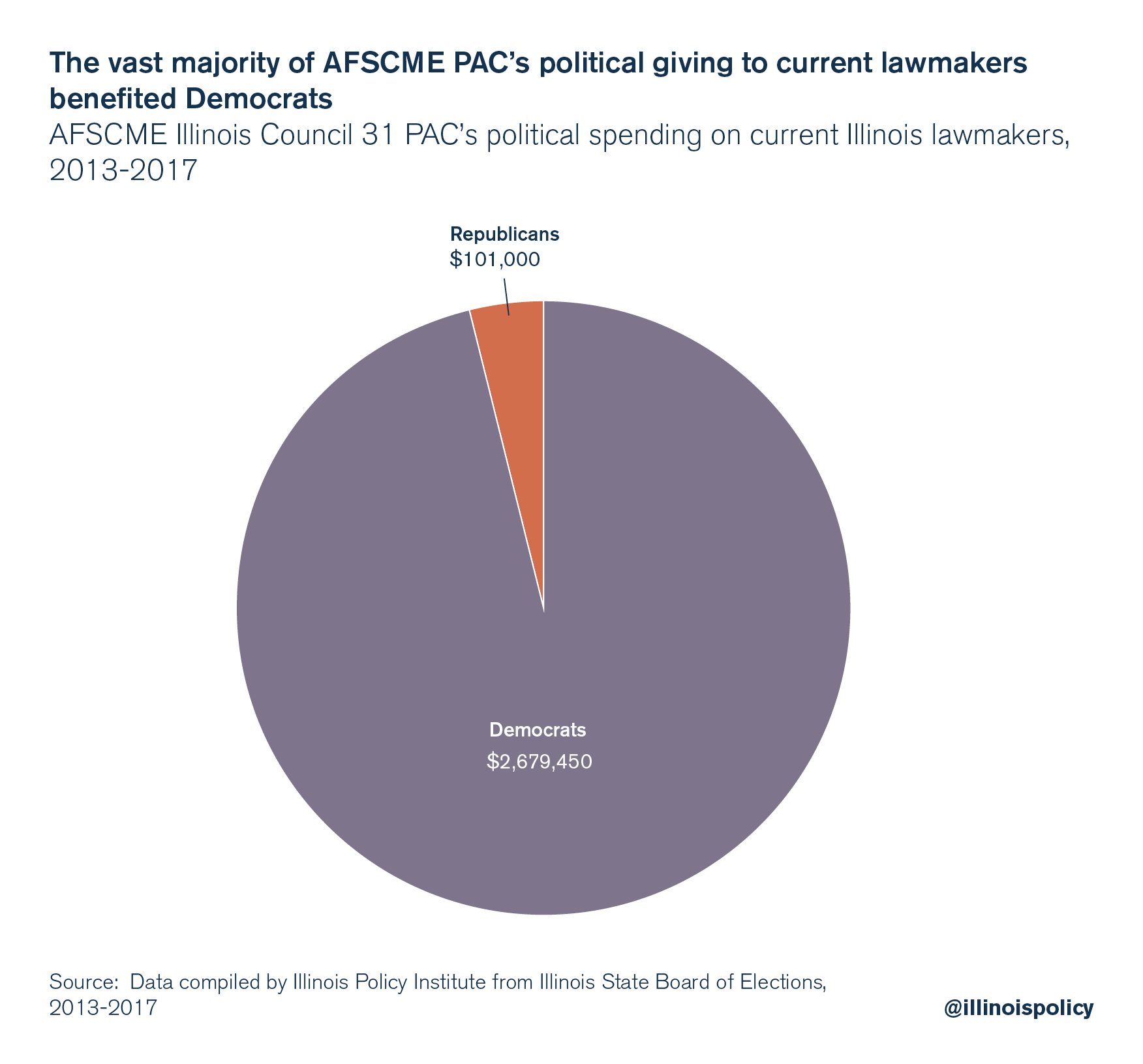
Finding No. 5: 104 of 177 current lawmakers have received money from AFSCME’s PAC – including 88 percent of current Democratic lawmakers
AFSCME’s PAC has donated money to more than half of current lawmakers in the Illinois General Assembly. Of the current 177 sitting lawmakers, the election committees of 104 received funding in the past five years.
That means AFSCME’s PAC provided funding to the election committees of large numbers of lawmakers tasked with making decisions about legislation affecting the union.
The party divide was stark. AFSCME’s PAC directed money to 92 Democrats (88 percent of total Democrats),22 but to only 12 Republicans (16 percent of total Republicans).23
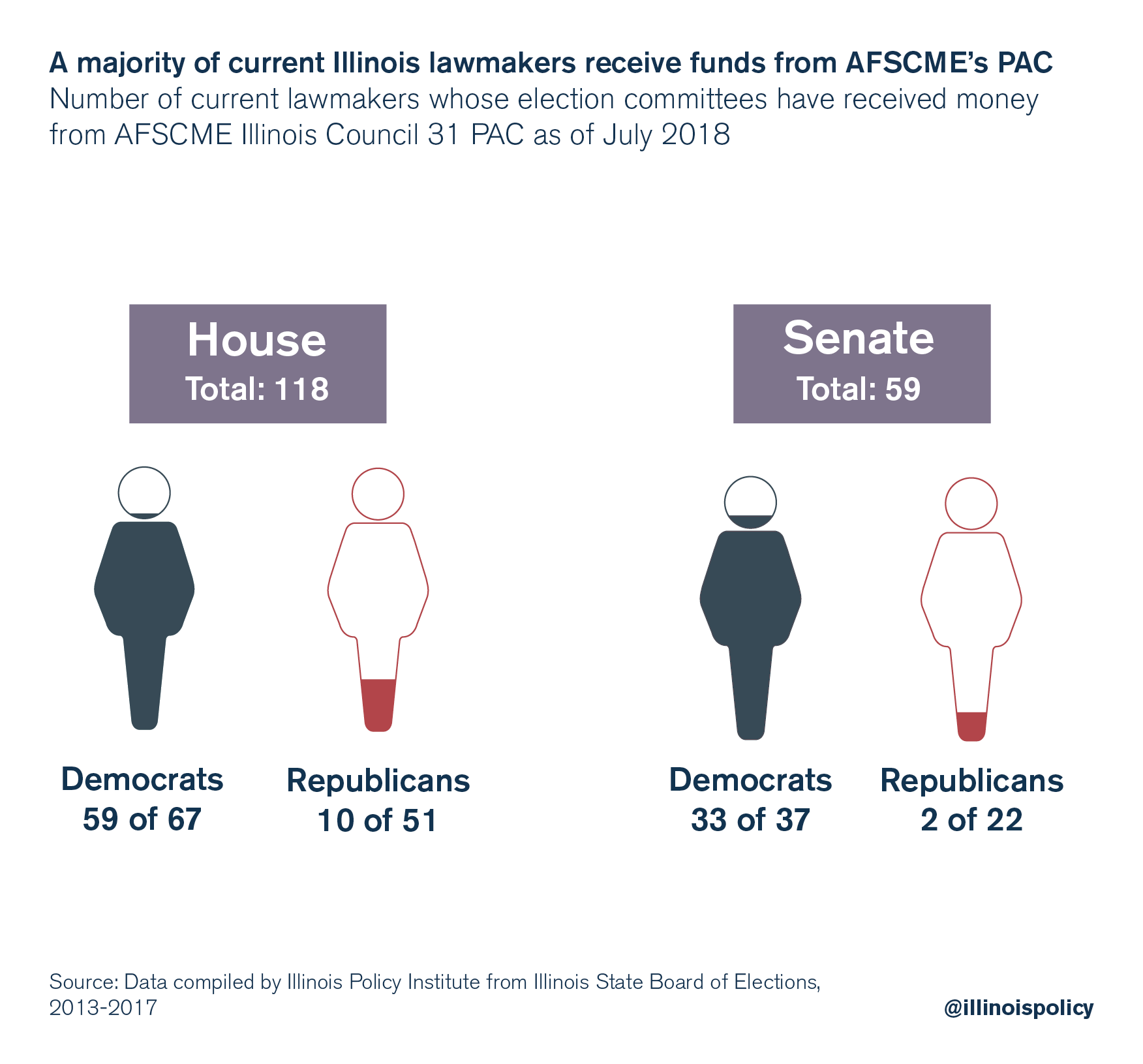
The overall picture is clear: AFSCME spends big on Democrats. Union members’ dues fund that political agenda – regardless of their own political preferences.
LAX REPORTING REQUIREMENTS IN FEDERAL LAW ALLOW AFSCME TO HIDE ITS TOTAL POLITICAL SPENDING
Council 31 is required to file documentation each year showing how much money flowed into the union and in what ways that money was spent. According to those documents, Council 31 spent more than $7.7 million on political activities and lobbying in the past five years.24 More than $3 million was directed to Council 31’s political account.25
But those documents are cumbersome and don’t tell the whole story. As a result, AFSCME can keep its members in the dark on its political spending.
Under federal law, some unions that take in $250,000 or more a year are required to file a financial report known as an LM-2.26 An LM-2 can be hundreds of pages long and is composed of a number of sections called “schedules,” which itemize the receipts and disbursements the union made during its fiscal year. Pertinent examples include money spent on the following:
- Representational activities (Schedule 15)
- Political activities and lobbying (Schedule 16)
- Contributions, gifts and grants (Schedule 17)
- General overhead (Schedule 18)
These schedules are intended to categorize the money the union spent. In theory, that would allow members to see how the union is using their dues money.
But there are loopholes. First, most of Council 31’s political spending is not itemized – meaning members can’t know what political causes the union supports. That’s because the bulk of Council 31’s political spending is on political activities and lobbying by its officers and employees – and the union doesn’t have to report in what political activities or lobbying those officers or employees participated.
Second, Council 31 has considerable discretion in how it categorizes its spending. While spending may look political to the average person, AFSCME can characterize it as something else and place it on a different LM-2 schedule. That skews its total reported political spending downward.
Most of Council 31’s political spending is not itemized – meaning members can’t know what political causes the union supports
Most of Council 31’s political spending is on activities or lobbying performed by its officers and employees – but there is no way to tell in what political activities or lobbying these workers participated.
A look at Council 31’s 2017 LM-2 demonstrates how this works – and how impossible it is for members to know where most of Council 31’s political efforts are directed.
In 2017, Council 31 reported spending $898,934 on political activities and lobbying (Schedule 16).27 Of that amount, only $165,888 was itemized:
- $61,848 to Crowne Plaza (legislative conference)
- $99,040 to Illinois AFL-CIO (assessments)
- $5,000 to Illinois AFL-CIO COPE (contribution)28
That means $733,046 in political spending – approximately 82 percent of the union’s reported political spending in 2017 – was not itemized in Schedule 16.
Where did that money go? One might look to Schedules 11 (All Officers and Disbursements to Officers) and 12 (Disbursements to Employees) to determine how this money was spent, but key details are missing.
Schedules 11 and 12 list all officers and employees of the union and their salary information. Along with the salary information is a breakdown of how those officers and employees spent their time – e.g., the percentage of time (salary) they spent on representational activities, political activities and lobbying, contributions, general overhead, and administration.
For example, the salary and category breakdown for Council 31’s Executive Director Roberta Lynch looked like this in 2017:

According to Schedule 11, 10 percent of Lynch’s time (salary) for Council 31 was devoted to political activities and lobbying.29
Lynch is only one of many officers and employees at Council 31. In all, the union spent more than $733,000 on the political activities and lobbying of its staff.30
Unfortunately, there is no way for members to know in what political activities those Council 31 staff members participated. They could have been lobbying for certain legislation, fundraising for Democratic candidates or engaging in other forms of politicking.
That’s the norm for Council 31. Of the $7.7 million the union reported spending on political activities and lobbying between 2013 and 2017, more than $4.2 million was directed toward the political activities and lobbying of officers and staff, in addition to other nonitemized disbursements.31 That means the direction of more than half of Council 31’s political expenses in the past five years is completely unknown.
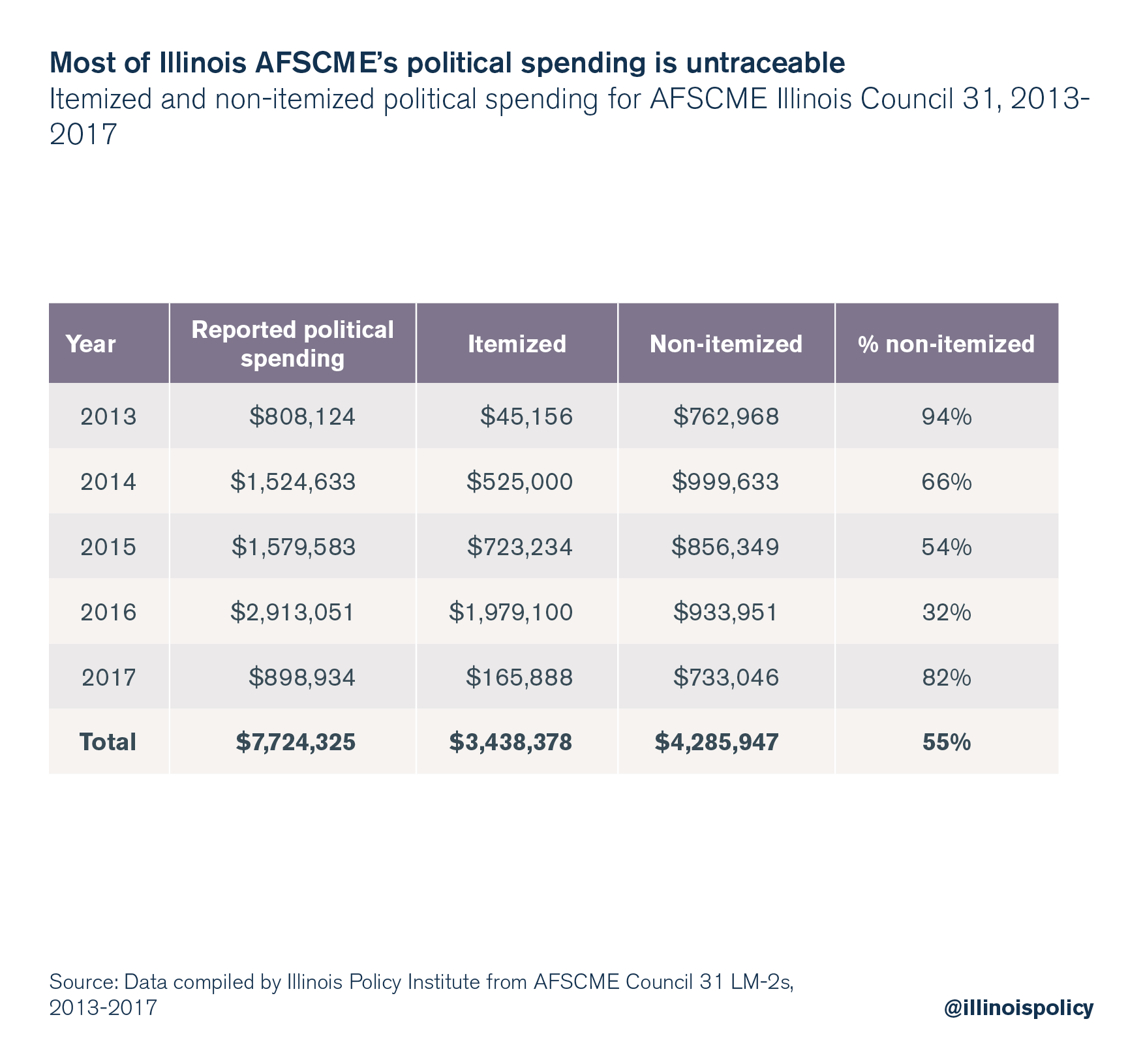
Exactly where was that political spending directed?
Council 31 isn’t saying. And its members have no way of knowing.
Council 31 can hide its political spending by claiming expenditures are for “overhead” or “representational” purposes – making it impossible to trace its true political spending
Council 31 has substantial discretion in determining how it characterizes the money it spends. While some spending may be political in nature, the union can categorize it differently, thereby downplaying the total amount of money it spends on politics and lobbying.
As previously discussed, LM-2s are divided into different categories, or schedules. In each schedule, the union is to list spending related to the schedule topic.
For example, “Schedule 18 – General Overhead” outlines spending “associated with general overhead that cannot be allocated to any of the other disbursements categories.”32
But during at least the past five years, Council 31 categorized as “general overhead” the almost $1.2 million it spent publishing and mailing its highly politicized newsletter, “On the Move.”33
That newsletter routinely outlines the union’s legislative agenda and encourages members to lobby their state lawmakers on AFSCME-supported or AFSCME-opposed bills.34 In its January-February 2018 issue, Council 31 listed union-supported candidates before the March 2018 Illinois primary.35 Likewise, the September-October 2016 issue included a “Voter Guide” enumerating candidates Council 31 recommended, including Hillary Clinton for president.36
That’s not “overhead.” That’s politics.
Significantly, Council 31 acknowledged the political nature of “On the Move” in its 2013 and 2014 LM-2s. In those filings, the union admitted that at least a portion of the work done by newsletter employees was “political” in nature.37
Not all Council 31 members support the politicians or causes the union supports – but they are forced to pay for the union’s political agenda with their dues money all the same. Council 31 hides it by characterizing the spending as “overhead.”
The union did the same in other LM-2 schedules. “Schedule 15 – Representational Activities” is supposed to include activities the union pursues in representing members in contract negotiations and then enforcing the contract that is ratified.38
But the following expenses – classified by Council 31 as “representational” in its 2016 and/or 2017 LM-2s – were highly political in nature:
- $34,618 on “Stop Rauner Ads”39
- $33,658 on “We Support State Workers” signs, a veiled political rallying cry against Gov. Bruce
- Rauner and his labor reform agenda40
$5,400 for charter buses to a union rally protesting Rauner and his budget priorities41
Similarly, Council 31 listed some contributions or gifts it made to inherently political organizations in a separate schedule – “Schedule 17 – Contributions, Gifts, and Grants” – instead of in the schedule on political activity. For example, between 2013 and 2016, the union directed more than $443,000 to Citizen Action Illinois, which describes itself as “leading the way in the fight for the progressive agenda.”42 Yet that spending is not listed by the union as political activity.
Altogether, Council 31’s utilization of the LM-2 form’s lax standards allows the union to spend money for political purposes without a full accounting to its members.
AFSCME HEADQUARTERS REPORTED SPENDING MORE THAN $205 MILLION ON POLITICAL ACTIVITIES BETWEEN 2013 AND 2017
AFSCME members don’t just pay dues to AFSCME Council 31. They also pay dues to AFSCME headquarters, which spends millions of dollars each year on political causes and candidates.
Between 2013 and 2017, AFSCME headquarters reported spending more than $205 million on political activities and lobbying.43 That spending was spread across the United States to a number of different politicians, political organizations and Democratic committees from the local to the national level.
Like Council 31, AFSCME headquarters’ political spending leaned heavily Democratic. For example, between 2013 and 2017 the union gave more than $3.6 million to Senate Majority PAC44 and House Majority PAC,45 which exist to help Democrats win seats in the U.S. Senate and U.S. House of Representatives, respectively.46 At the state level, AFSCME gave more than $3.2 million to the Democratic Legislative Campaign Committee,47 which is committed to getting local Democrats elected to statehouses across the nation.48 AFSCME headquarters’ 2013-2017 LM-2s do not reveal any funding going to any similar organizations of other political parties.
Along that same line, AFSCME headquarters gave more than $6 million49 to the following state and local Democratic associations, but its LM-2s do not show money going to similar associations of other political parties:
- Democratic Governors Association50
- Democratic Lieutenant Governors Association51
- Democratic Attorneys General Association52
- Democratic Association of Secretaries of State53
- National Democratic County Officials54
- National Conference of Democratic Mayors55
- Democratic Municipal Officials56
In Illinois, AFSCME headquarters directed money to the election committees of the following Democratic candidates:
- House Speaker Mike Madigan57
- State Rep. Katie Stuart58
- State Rep. Mike Halpin59
- State Rep. Sam Yingling60
- Former State Rep. Mike Smiddy61
- Former State Rep. Kate Cloonen62
- Former State Rep. Daniel Beiser63
- House candidate Greg Hose64
- House candidate Merry Marwig65
AFSCME headquarters directed money to the election committee of only one Illinois Republican during 2013-2017: Former gubernatorial candidate and state Sen. Kirk Dillard.66
Similar to Council 31, the political spending of AFSCME headquarters spiked in even-numbered years. In fact, its political spending doubled in election years, eclipsing even the amount of money the union spent on “representational” activities – i.e., the act of representing members, which is the stated purpose of government worker unions.67
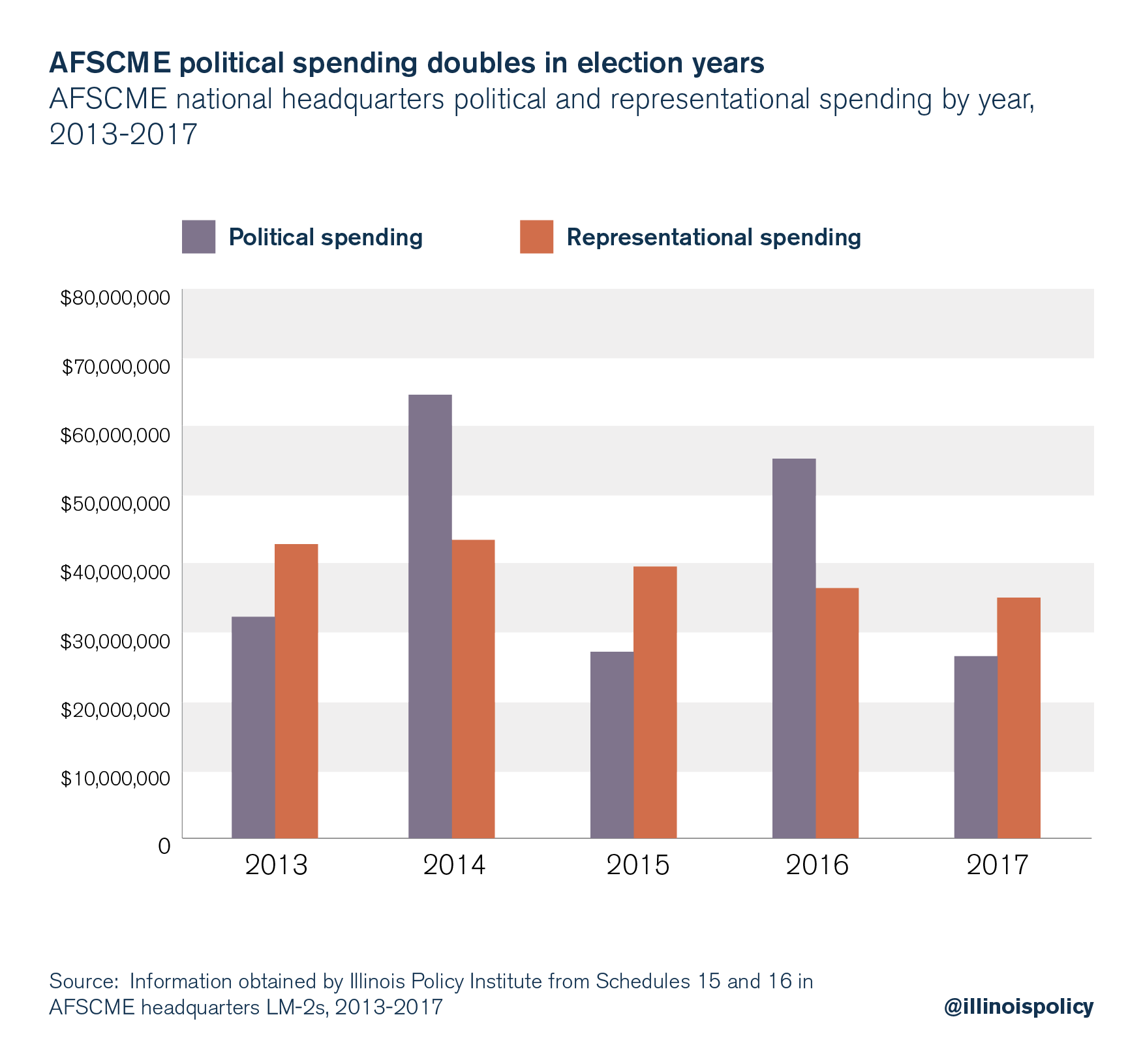
Union members have no say in the spending patterns of AFSCME headquarters, and indeed, the union funded organizations that many members may find objectionable. Examples include the following:
- More than $7.8 million to For Our Future and its PAC, which is “committed to serving progressive values”68
- More than $3.4 million to Americans United for Change, an organization seeking to return to “traditional progressive values”69
- More than $3.3 million to America Votes, an organization that bills itself as “the coordination hub of the progressive community”70
CONCLUSION
Council 31, its PAC and AFSCME headquarters are major political players, funneling millions of dollars every year to Democrats or self-proclaimed progressive organizations. That’s fine – if members agree with the way that money is spent.
But polling reveals 40 percent of union households voted Republican in the 2016 presidential election.71 In fact, an average of nearly 40 percent of union households has voted Republican in the past five presidential elections.72
Clearly, there is a misalignment between the priorities of AFSCME leadership and those of many of the workers it purports to represent.
Union members upset with AFSCME’s political priorities are not without redress. While they cannot dictate how their union dues are spent, now they can decide whether the union gets their money at all.
In the case Janus v. AFSCME, the U.S. Supreme Court relieved union members from being forced to pay union fees – restoring for the first time in 40 years the right of government workers to determine for themselves which organizations they financially support.73
To best make that decision, union members should be equipped with the facts on what AFSCME spends, and what it hides.
Spending on Link
https://www.illinoispolicy.org/reports/madigans-money-afscme-spending-trail-reveals-extensive-and-hidden-political-activity/?fbclid=IwAR3V2DxdHNPT1gGXtpTwGjcX53-ojfc-aLMgP31LbgNc6ZHhCHZZQcp-k8U

No comments:
Post a Comment